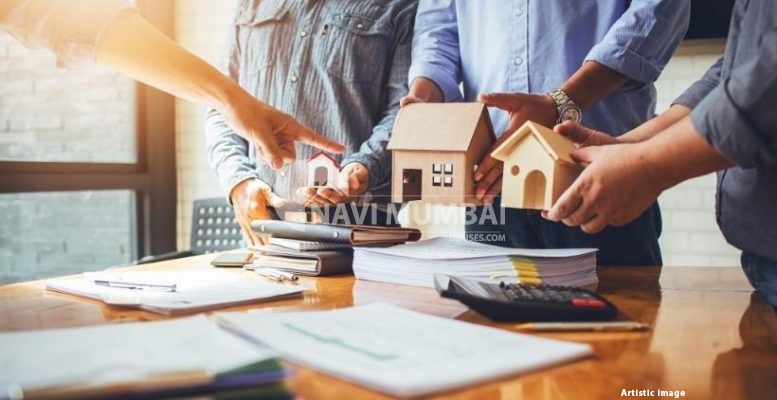
- June 8, 2022
- News
Maharashtra’s Step-By-Step Roadmap To Self-Improvement
Maharashtra’s Roadmap : Self-redevelopment, a prominent concept in Maharashtra, is a process in which the community’s upkeep is the responsibility of the people rather than the builder. The approach offers you more control over the project and lowers the risk of delays and money theft. Outlines the key elements of self-restoration and provides a step-by-step guidance for carrying it out in accordance with Maharashtra’s new Development Control Regulations (DCR).
Are you looking for flat on rent in panvel?
Due to delay project deliveries and a lack of faith among developers, several Maharashtra housing societies have been compelled to turn to self-redevelopment. In Mumbai alone, there are around 16,000 deteriorating co-operative housing societies, with over 750 choosing for self-redevelopment. While the self-revamping approach ensures time-bound, cost-controlled, and predictable results as society members take up project restoration responsibilities, there may be some legal and technological hurdles. As a result, as per the Government Resolution (GR) released in September 2019, below is a comprehensive guide to self-development in Maharashtra.
Step 1: Obtain the members of the society’s consent.
The first stage is to obtain approval from residents/members for society’s self-development. For this, societies must call a Special General Body Meeting, which must be announce to all members and the local registrar, who will send a representative to lead the meeting.
Reconstruction projects now require only 51 percent of unit owners’ permission, as compare to 70 percent previously, under the amended Section 79A of the Maharashtra Cooperative Societies Act, 1960. The acknowledgment should be sign by all members, and a copy should be kept for future reference.
Step 2: Obtain a feasibility study
Existing building plan, consumed Floor Space Index (FSI), carpet area of existing units, amended TDR, fungible FSI, current development laws, and cost breakdown for project implementation are all included in a structural analysis or feasibility report. The study is organise into three sections: technical feasibility, financial feasibility, and advantages from the idea, which include the prospect of future development and sale.
Societies should employ an architect to create the report and distribute it to all members of the group.
Step 3: Review all of your important documents.
The group’s name must be on the transfer document. If the land to be redeveloped belongs to the Maharashtra Housing and Development Entity (MHADA), the Collector, or any other body, a No-Objection Certificate (NOC) from the owner is necessary.
Maharashtra’s Roadmap : Other papers required for the redevelopment process include:
- Plan for a Chain and Triangle Survey (CTS).
- excerpt from 7/12
- Remarks on the Development Plan
- Redevelopment proposals that have already been authorised
- The building’s Occupancy Certificate (OC)
- Financial statements for the previous three years that have been audited
- A current copy of the bylaws
- The society’s registration certificate
- Members of the Committee
- Approved amenities copy
- Details about the setback zone
- Measurements of the plot area
- All members of the society are listed, along with their unit sizes according to the real plan.
Step 4: Assemble a group of specialists.
Having a team of professionals, such as a certified accountant, legal counsel, and architect, saves time and reduces the risk of making a mistake. A chartered accountant may help with accounting, income tax, and the Goods and Services Tax (GST), whilst a legal counsel can assist with RERA and other legal needs. Recruiting a competent contractor is also necessary for the society’s rehabilitation.

Step 5: Obtain the necessary approvals
“Obtaining permissions use to be a massive task; today, the Maharashtra government has decided to allow self-redevelopment projects to be cleare in a single window.” Coastal Regulation Zone (CRZ) Clearance, Environment Clearance. And NOCs from traffic, fire, defence, railroads, and aviation authorities. Among others, are often require for self-redevelopment projects,”
Step 6: Make financial arrangements
The bank will want the names and addresses of all of the society’s members in order to obtain a loan. The firm address, the native place address, the Aadhaar card, and the PAN card are all examples. Copies of Income Tax Returns (ITRs) and pay slips are also require for members who do not file their ITRs. In addition, society must provide a facsimile of the contracts signed with architects, contractors, legal advisors, and chartered accountants.
Maharashtra’s Roadmap : Furthermore, there cannot be none –
- Dues that have not been paid in the name of the society
- The residents owe outstanding maintenance fees.
Under the 2018 self-redevelopment initiative, the highest credit amount available is Rs 50 crores. The loan under this programme is for seven years, with two of those years serving as a moratorium period during which no payments to the bank are require. The loan tenor for rehabilitation projects costing more than Rs 50 crores would be ten years, with a three-year initial moratorium period.

Step 7: Make temporary accommodation arrangements and verify that all standards are satisfied.
Make arrangements for the residents’ temporary accommodation while the project is being constructed. Once the rebuilding is complete, the architect must acquire authorization from the Municipal Corporation for a new building design, adhere to all rules, and have the society pay the premium charges. Meanwhile, if any more units are installe with the aim to sell. The legal counsel will register the project under Maharashtra RERA.
Handing over the new premises to members, closing accounts. Submitting income tax, and GST reports are all important tasks that must be completed when the project is completed. Additionally, while current residents are exempt from paying stamp duty, owners of newly constructed apartments will be responsible for paying the stamp duty and registration cost.
Maharashtra’s Roadmap : Important considerations
In September 2019, the Maharashtra government released a new Government Resolution (GR). To provide many exemptions and incentives to societies who choose self-restoration. However, the advantages are only available to cooperative housing societies that are register under the Maharashtra Cooperative Societies Act. 1960 and were built during the last 30 years.
Maharashtra’s Roadmap : FSI standards
A community that chooses self-restoration is entitled to an additional FSI of 10% under the new Government Resolution rules. In addition to what it is entitled to under the area’s development laws.
Furthermore, society is entitled to a reduction on premiums paid for additional FSI.
Maharashtra’s Roadmap : In TDRs, there is a rebate.
The payments for Transfer of Development Rights (TDS) would be half of what society would normally pay.
You’re looking for Rental Home In Kharghar we have the Best Rental Properties In Kharghar Like Ready to Move & Nearby possession: https://navimumbaihouses.com/property/search/rent/kharghar/
If you want daily property update details please follow us on Facebook Page / YouTube Channel / Twitter


7 Comments
Pingback: 토렌트
Pingback: ozempic comprar sin receta, comprar ozempic online, ozempic comprar, comprar ozempic
Pingback: https://www.timesunion.com/marketplace/article/phenq-reviews-17525542.php
Pingback: Ks Quik
Pingback: วิธีการแก้ไข เข้า LSM99 ไม่ได้ จะต้องทำอย่างไร
It’s a game. Five dollars is free. Try it It’s not an easy game ->-> 토토사이트.com
>>> It’s a game. Five dollars is free. Try it It’s not an easy game ->-> 토토사이트.com